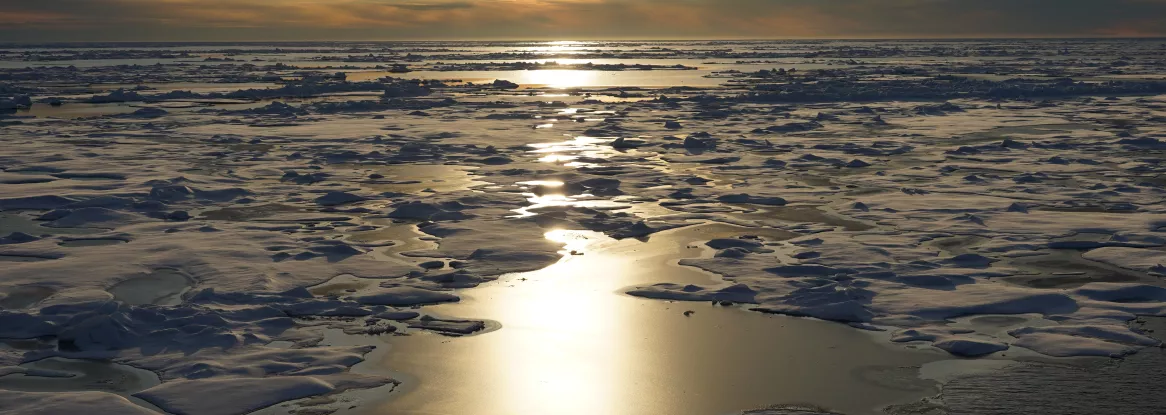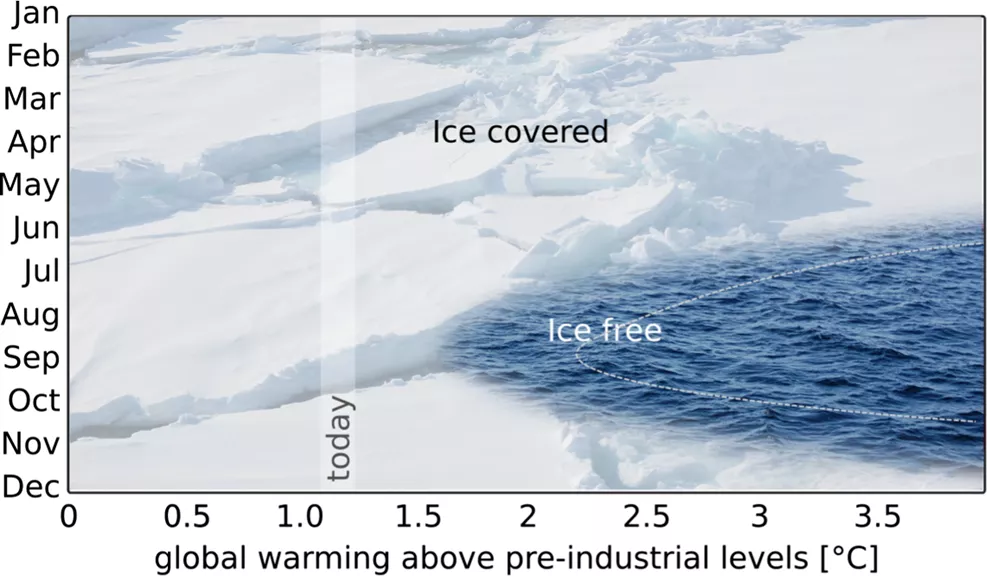By Walt Meier
When Arctic sea ice set a dramatic new record low minimum extent in September 2007, scientists were stunned. By that time, the decline in sea ice extent was clear, so a new record low was not surprising. However, the magnitude of the drop—over 1 million square kilometers (386,000 square miles), or 22 percent below the previous record low—was unexpected. Around that time, there was some discussion about a potential “tipping point” where Arctic sea ice could rapidly drop over a period of a few years to a state of ice-free summer conditions. The posited reason for this was the “sea ice-albedo feedback.” Sea ice reflects more sunlight than the darker ocean and thus absorbs less solar energy. When sea ice is lost, the greater ocean area absorbs more energy, heats up, and melts yet more sea ice—an amplifying cycle.
However, as sea ice reached this record low, most scientists were cautious and recognized that further study was needed to determine if and when the Arctic Ocean would be seasonally ice-free. For something as complex as climate, it is important to not focus too much on a single extreme event or on short-term trends. And that caution proved to be wise in regard to Arctic sea ice.
Rebounding ice
In subsequent years, even as another record low was set in 2012, research suggested that a continued steep drop-off of Arctic sea ice was not likely. In 2011, a modeling study showed that when sea ice was “removed” from the model at the end of a summer, the ice rebounded over the next few years. Why would this occur? Along with the sea ice-albedo feedback that enhances ice loss, there are offsetting factors. One is that thinner ice grows faster than thicker ice and the fastest ice growth occurs right as the ice is forming. So, in an extreme year such as 2007 or 2012, there is a lot of open water remaining at the end of summer. More open water during the summer means the ocean absorbs more heat, which must be lost to the atmosphere before ice can begin forming, but this does not delay sea ice growth much.
As the sun sets for the winter and the atmosphere cools, the ocean surface starts to rapidly cool. Once the ocean loses its heat and reaches the freezing point, the vast area of open water begins to rapidly freeze. The ice grows thicker faster in these open areas than in areas where ice already exists. So, after an extreme summer, in open water areas, the ice growth can “catch up” to some degree over the winter.
At the most basic level, extremely low sea ice extents are the result of extreme spring and summer weather conditions—unusually warm, sunny conditions and/or winds that facilitate more ice loss. But extreme conditions do not happen every year and there is generally a “reversion to the mean,” where the subsequent years are not as extreme. This allows sea ice to rebound from the extreme low of one year, as it did after 2007 and 2012. Another study indicated that even when there is an overall long-term downward trend, periods of a decade or even two decades may be stable or even have slight increases in sea ice extent. So, even 10 years after 2012, it is not surprising that there has not been another record low in Arctic sea ice.
Is the Arctic recovering?
However, this does not mean the Arctic sea ice is recovering or that the long-term downward trend has ended. While there has not been a new record since 2012, there has been no recovery in the ice cover. In fact, the last 16 years, 2007 to 2022, are the lowest 16 years in the 44-year satellite record. And there is a good reason to believe that the long-term downward trend will continue. Ultimately, sea ice responds to temperatures: warmer temperatures mean less ice. As greenhouse gas emissions continue to rise, Arctic temperatures will continue to rise as well. Another study found that the long-term sea ice extent trend follows a linear relationship with temperature and the atmospheric greenhouse gas level. Along this long-term trend, there will be ups and downs from year to year and even over several years, as we have seen in the observations, but the trajectory is still clearly towards a seasonally ice-free Arctic Ocean unless greenhouse gas levels stop increasing. So, scientists are conservative about predicting an exact year that we will see a “blue Arctic Ocean” during the summer because of the influence of weather and short-term climate variations. However, under current emissions trajectories, it is coming. In other words, the downward path of Arctic sea ice will continue, but it is going to be a bumpy ride.
References
Curry, J. A., J. L. Schramm, and E. E. Ebert. 1995. Sea ice-albedo climate feedback mechanism. Journal of Climate, 8(2), 240-247, doi:10.1175/1520-0442(1995)008<240:SIACFM>2.0.CO;2.
Lindsay, R. W., and J. Zhang. 2005. The thinning of Arctic sea ice, 1988-2003: Have we passed a tipping point? Journal of Climate, 18(22), 4879-4894, doi:10.1175/JCLI3587.1.
Kay, J., M. M. Holland, and A. Jahn. 2011. Inter-annual to multi-decadal Arctic sea ice extent trends in a warming world. Geophysical Research Letters Climate. doi: 10.1029/2011GL048008.
Notz, D., and J. Stroeve. 2016. Observed Arctic sea-ice loss directly follows anthropogenic CO2 emission. Science. doi:10.1126/science.aag2345.
Notz, D., and J. Stroeve. 2018. The trajectory towards a seasonally ice-free Arctic Ocean. Current Climate Change Reports, 4, 407-416, doi:10.1007/s40641-018-0113-2.
Perovich, D. K., and C. Polashenski. 2012. Albedo evolution of seasonal Arctic sea ice. Geophysical Research Letters, 39, L08501, doi:10.1029/2012GL051432.
Tietsche, S., D. Notz, J. H. Jungclaus, and J. Marotzke. 2011. Recovery mechanisms of Arctic summer sea ice. Geophysical Research Letters, 38, L02707, doi:10.1029/2010GL045698.


